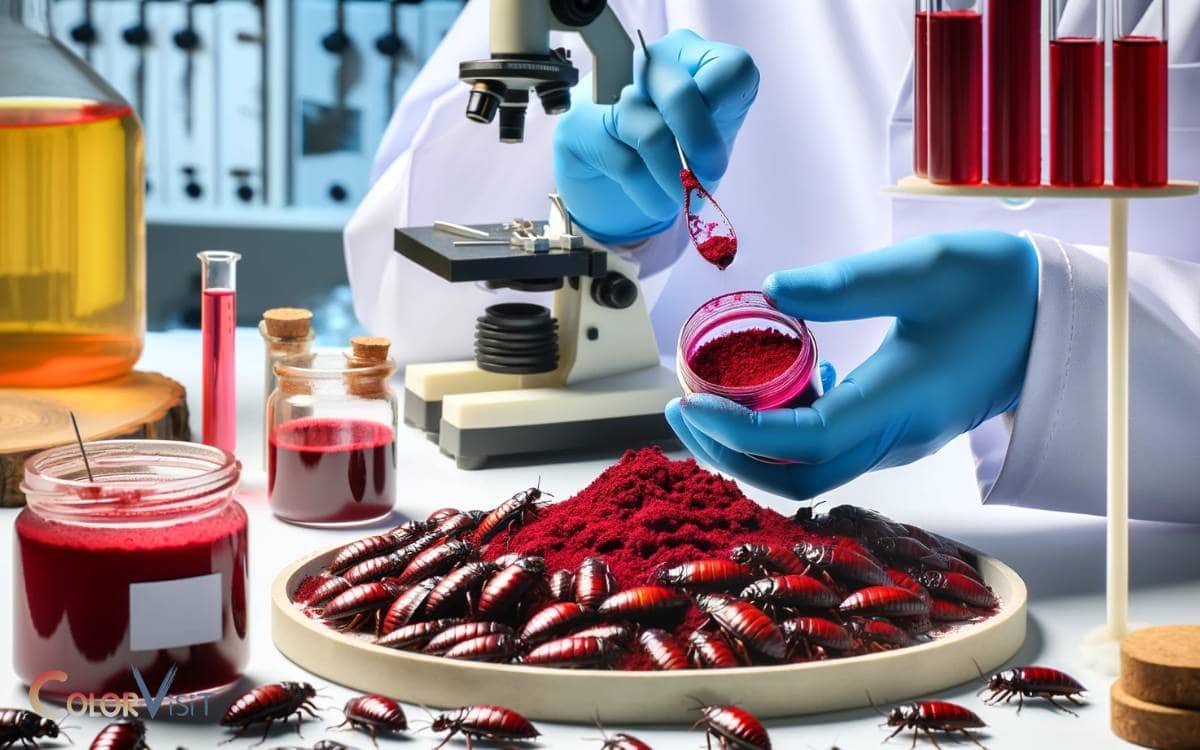How to Make Carmine Red Color? 5 Steps!
Creating carmine red, a vivid color with historical significance, involves processing cochineal insects. These insects are farmed, harvested, dried, and then crushed to produce a powder.
Carmine red is derived from carminic acid, which is obtained from cochineal insects. These insects are native to Latin America and are parasitic on certain cactus species.
The process of making carmine red can be simplified as follows:
Harness the power of nature to craft the perfect shade of carmine red. This sustainable method of color production not only offers rich pigmentation but also pays homage to the traditional practices of dye making.
Key Takeaway
Step 1: Understanding Carmine Red
Carmine red is a pigment derived from the cochineal insect, commonly used in art and cosmetics for its vibrant and long-lasting color.
- This natural dye has gained attention for its sustainable and eco-friendly properties, appealing to an audience that seeks innovative and environmentally conscious solutions.
- The process of creating carmine red involves carefully harvesting the cochineal insects, drying them, and then crushing the dried bodies to extract the red pigment.
- This ancient technique has stood the test of time due to the unparalleled richness and depth of color it produces.
As the demand for natural and sustainable products continues to rise, carmine red remains a symbol of tradition meeting modern innovation, offering a unique and timeless option for artists and cosmetic manufacturers.
Step 2: Sourcing the Necessary Ingredients
One must source the necessary ingredients to create carmine red color from reliable and sustainable suppliers to ensure the quality and authenticity of the pigment.
- The primary ingredient, cochineal insects, can be ethically and sustainably sourced from certified organic farms.
- It is essential to verify that the supplier follows ethical and environmentally friendly practices in harvesting and processing the insects.
- Additionally, the use of natural mordants and fixatives, such as alum and cream of tartar, should be sourced from reputable sources to ensure the stability and vibrancy of the resulting pigment.
By prioritizing sustainable and ethical sourcing practices, the resulting carmine red color will not only be of the highest quality but also aligned with environmentally conscious principles.
Step 3: Extracting the Natural Pigment
In the process of making carmine red color, extracting the natural pigment is a crucial step.
This involves carefully sourcing natural pigment sources and understanding the carmine extraction process.
Additionally, knowledge of color application techniques is essential for achieving the desired hue and vibrancy.
Carmine Extraction Process
The extraction process for obtaining the natural pigment of carmine involves a series of complex chemical and biological procedures.
- It begins with the harvesting of female cochineal insects, which are then carefully dried and crushed to obtain the carminic acid-containing pigment.
- The next step involves a meticulous extraction process using either an acidic, aqueous, or alcoholic solution to release the pigment from the insect bodies.
- This process requires precise control of temperature, pH, and extraction time to ensure the highest pigment yield and quality.
- Once extracted, the carmine pigment undergoes purification and concentration processes to remove impurities and obtain the desired color intensity.
This intricate extraction method is crucial in producing high-quality carmine pigment for various applications.
Natural Pigment Sources
Having completed the extraction process outlined in the previous subtopic, the natural sources of carmine pigment, primarily derived from the cochineal insect, play a crucial role in obtaining the desired colorant for various applications.
- The natural pigment sources are obtained by carefully harvesting the female cochineal insects, drying them, and then crushing them to extract the carminic acid.
- This acid is then processed to create the vibrant carmine red color.
- Additionally, scale insects such as the Polish cochineal and Armenian cochineal also serve as natural sources for carmine pigment.
These natural sources provide a sustainable and innovative approach to obtaining carmine red color, catering to the needs of industries such as food, cosmetics, and textiles, where natural and eco-friendly solutions are highly valued.
Step 4: Adjusting the Hue and Intensity
Techniques for adjusting the hue will be explored, along with methods for enhancing the intensity of the color.
These adjustments are crucial in achieving the desired shade and vibrancy of carmine red.
Hue Adjustment Techniques
When adjusting the hue and intensity of carmine red color, it is essential to employ precise and controlled techniques to achieve the desired color variation.
- One innovative technique for adjusting the hue and intensity of carmine red is by using colorants and pigments in varying concentrations.
- Another method involves blending carmine red with complementary colors such as green or blue to create different hues and intensities.
Additionally, digital color manipulation tools can be utilized to finely tune the hue and intensity of carmine red.
The table below illustrates some techniques for adjusting the hue and intensity of carmine red color:
| Technique | Description |
|---|---|
| Varying Concentrations of Colorants | Adjust the intensity by altering the concentration |
| Complementary Color Blending | Blend carmine red with complementary colors |
| Digital Color Manipulation Tools | Utilize digital tools for precise hue and intensity |
| Heat and pH Adjustment | Modify hue through temperature and pH variations |
| Light and Dark Value Adjustment | Adjust intensity by altering light and dark values |
Intensity Enhancement Methods
To enhance the intensity of carmine red color and adjust its hue, employing precise techniques is crucial in achieving the desired color variations.
- One effective method is to mix carmine red with a small amount of a brighter red, such as cadmium red, to intensify the hue and increase its vibrancy.
- Another approach involves adding a touch of orange to the carmine red, which not only enhances the intensity but also warms the hue.
- Additionally, incorporating a tiny amount of a deep, cool blue, like ultramarine, can deepen the intensity of carmine red while imparting a subtle shift in hue towards a cooler tone.
These methods allow for innovative adjustments, providing a spectrum of intensified carmine red shades for various artistic and design applications.
Step 5: Storing and Using Your Homemade Carmine Red
The proper storage and use of homemade carmine red is essential for maintaining its quality and vibrancy.
To ensure optimal results, consider the following:
- Airtight Containers: Store the homemade carmine red in airtight containers to prevent exposure to air and moisture, which can compromise its color intensity.
- Cool, Dark Place: Keep the carmine red in a cool, dark place away from direct sunlight to prevent fading and color distortion.
- Proper Sealing: Ensure that the containers are tightly sealed to prevent evaporation and maintain the color’s richness.
Maintaining the quality of your homemade carmine red through proper storage is crucial for achieving consistent results in your artistic endeavors.
Tips for Achieving Consistent Results
Achieving consistent results in carmine red coloration requires precise measurement and meticulous execution.
- To ensure a uniform and reliable outcome, it is essential to carefully source and measure the ingredients, adhere to the specified ratios, and maintain a controlled environment.
- Utilizing high-quality cochineal insects and following standardized extraction methods can contribute to the consistency of the color.
- Additionally, maintaining accurate pH levels and monitoring the temperature during the production process are critical factors in achieving the desired hue of carmine red.
- Regular calibration of equipment, such as pH meters and thermometers, is vital for accuracy.
- Furthermore, documenting each step of the process and analyzing the results can provide valuable insights for refining the coloration method and achieving consistent, high-quality carmine red.
Conclusion
Creating carmine red is a complex and delicate process that requires patience and precision.
By sourcing the necessary ingredients, extracting the natural pigment, and adjusting the hue and intensity, one can achieve a vibrant and rich carmine red color.
Consistent results can be achieved with careful attention to detail and proper storage. Like a skilled artist, mastering the art of making carmine red is a rewarding and fulfilling endeavor.







